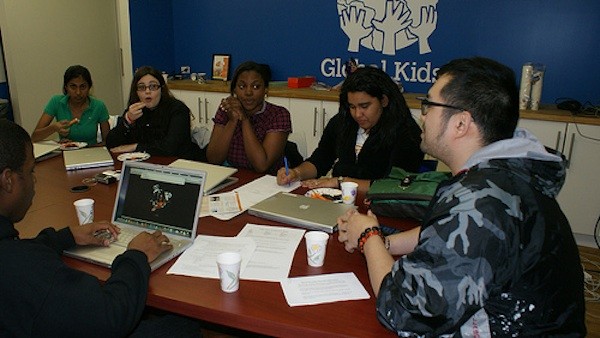Recommended Reading, Viewing, Clicking

Editor's note: Global Kids does a great job searching, sorting, and filtering the 24/7 flow of resources in the digital media and learning field. We've asked them to sift through their current picks and point us to some of the best. Please share what you're reading or watching and why others should as well!
At the top of this month's list is an amazing music video,"Virtual Love" by Legrand. A collaboration among 20 Japanese students at Temple University in Tokyo and Philadelphia based on hip hop artist Legrand, the music video integrates a variety of social media and simple desktop applications into one seemingly seamless computer screen capture. So clever and interesting. As so much of our work at Global Kids uses digital media to connect people in different places, it is always exciting to see examples of people pushing the envelope
Smithsonian Commons (web site)
Now, THIS is exciting. The Smithsonian Commons is a new part of the Smithsonian Institute's "digital presence dedicated to stimulating learning, creation, and innovation through open access to Smithsonian research, collections and communities." Imagine all the content of the Smithsonian Museums. Now imagine all of the content available online, not just on a website to consume but as something to be remixed, mashed up, and reconstructed. It's still VERY new, but check out their videos describing different ways it might be of use to people. As we do a lot of work with museums, it is very inspiring to see such a bold vision and willingness to experiment.
"Revolution Needed for Teaching Literacy in a Digital Age" (blog post)
Esther Wojcicki, board chair of Creative Commons, and Michael Levine, executive director of the Joan Ganz Cooney Center at Sesame Workshop, posted this call to arms on The Huffington Post. They ask: "Why should everyone care how well kids read at the fourth grade? Because children who are below grade level by age ten tend to stagnate and eventually give up and drop out in high school. Harvard educational psychologist Jeanne Chall famously called this phenomenon the 'fourth grade reading slump,' where children cannot make the transition from learning to read to 'reading to learn,' which hinders their learning in all other subjects...Educational video games, simulations, modeling tools, handheld devices, and media production tools can allow students to see how complex language and other symbol systems attach to the world. Digital media has the potential to increase the 'book' vocabulary, and the concepts attached to such words, for children whose families are unable to do so." Their recommendations: 1) establish a Digital Teacher Corps; 2) provide incentives for schools of education to update curriculum; 3) design alternative assessments and include project based learning in standards; 4) support after-school programs and create a "Digital Hangout for Kids" in every community; 5) establish Model Digital Schools in every state; and 6) modernize public broadcasting. Efforts like these are crucial to our work at Global Kids as we have been advocating many of these same recommendations for years and hope their discussion in The Huffington Post helps bring them to fruition.
Disrupting Class by Clayton Christensen (book)
No book this year has been referenced more often at conferences we've attended. After reading it, we understood why. Disrupting Class offers a valuable analysis and framework for innovating change within educational institutions. Inspired by the work on multiple intelligences by Howard Gardner, the writer's goals are to describe a viable path to an educational system that will effectively support all youth to learn in whatever way they need to. And digital media is key to that process. Perhaps the most important book to appear on our list all year.
An Evening to Re-imagine Learning in the 21st Century (video)
The MacArthur Foundation recently hosted an event at New York City's New School that included discussions and project demonstrations focused on re-imagining learning for the 21st century. This portion of the video (one of three from the event) features Karen Cator, director, Office of Educational Technology at the U.S. Dept. of Education, with opening remarks by Keith Krueger, CEO of the Consortium for School Networking. If you are new to the remarkable National Educational Technology Plan, we can't imagine a better overview.
Media Education: Literacy, Learning and Contemporary Culture by David Buckingham (book)
This comprehensive book accomplishes an important task of helping to define the field of Media Education as it stood at the turn of the millennium. Written in 2003, he hints at some of the more contemporary issues associated with new media that have become more fleshed out as the digital media and learning (DML) field has grown; how childhood is changing as a result of digital media, emerging digital literacies and youth media production. However, the primary strength of this work is to chart some of the history, stances, and practices that defined media education when it was mostly concerned with preparing youth to engage with mass media in critical and reflective ways. As the DML field expands and takes shape, works like this have important lessons to offer as we design new practices and address unexpected problems in a fast-changing media environment.
Image credit: Holy Meatballs http://www.flickr.com/photos/holymeatballs/4599359087/in/set-72157623918526097/
Global Kids' NYC-based programs address the need for young people to possess leadership skills and an understanding of complex global issues to succeed in the 21st century workplace and participate in the democratic process. GK’s Online Leadership Program integrates youth development, public policy issues, and media into programs that build and promote digital literacy, meaningful online dialogues, resources for educators, and civic participation.